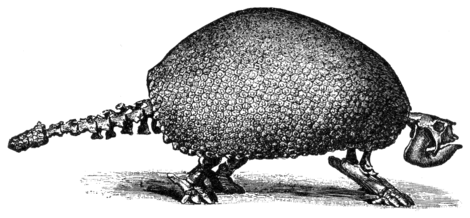On the manus, the three inner digits have powerful claws. This animal, too, was Pleistocene in time. The Megatheriidae had, however, small as well as gigantic forms.
The genus Zamicrus had a skull no bigger than that of a Sloth, while Nothrotherium was also a comparatively small creature; the teeth of the latter genus are reduced to 4/3.
The extinct group of the Glyptodontidae comprises large creatures with a dense covering of bony scutes which are arranged in a tesselated fashion, and thus form an immobile armature of immense strength. In correspondence with this massive carapace the dorsal vertebrae have fused together, and the lumbar vertebrae form a series ankylosed to each other and to the following sacrals. These creatures are all South American.

Fig. 106.—Glyptodon clavipes. × 1⁄12. (After Owen.)
Glyptodon, the genus which gives its name to the family, is known from numerous remains in South America, and also from so far north as Texas and Mexico. It grew to be as long as 16 or 17 feet. In the skull there is an exceedingly long downward process of the zygomatic arch, as in Sloths, the arch itself being complete. The process extends so far down as to reach a point about on a level with the middle of the lower jaw. The nasals are short or rudimentary. As in Myrmecophaga, the pterygoids enter into the formation of the bony palate. The lower jaw has a spout-shaped extremity, and, behind, it rises into an enormous vertical branch as high as the front part of the jaw is long. There are eight teeth in each half of each jaw. As in
